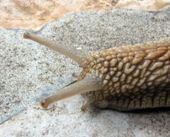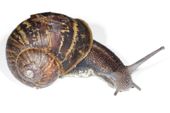Adaptation
Many terrestrial snails have developed several adaptations for survival. Although specific adaptations for Gastrocopta tappaniana are unknown, this species of snail shares at least the common adaptations with many other snails.
Snails are able to secrete a mucus which aids in movement as well as prevents the snail from drying out. Also, many gastropods are able to withdraw their bodies inside their shells and can seal the entrance with a tough plate called an operculum. The operculum protects the snail from predators and from desiccation (Hickman, 2009).
Snails are unable to hear and many have poor sight so the development of tentacles has allowed snails to have chemosensory structures to sense food, predators, and their environments (Illinois Department of Natural Resources, 2009).
Land snails have a large, muscular foot which allows the snail to glide. The muscles contract in a waving motion, moving the snail forward.
Many gastropods also go through a process known as coiling. As the snail's mantle secretes more shell, the shell begins to coil which keeps the snail at a reasonable size so that movement is not hindered (Hickman, 2009).
Another neat adaptation that many snails have developed is the "homing tendency." Many snails have the ability to find their same sheltered area again after moving throughout the day. These homing tendencies reduces the risk of the snail traveling to dangerous habitats (Illinois Department of Natural Resources, 2009).
To learn more about general information on snails, check out the poster created by the Illinois Department of Natural Resources at the website listed below.
http://www.dnr.state.il.us/publications/pdf/00000656.pdf
Back to Home Continue to Nutrition

